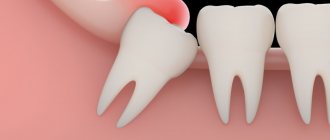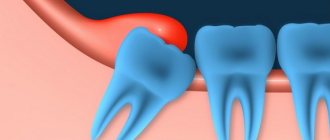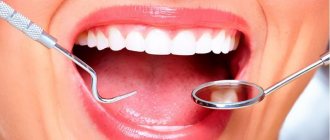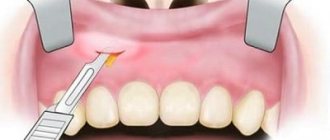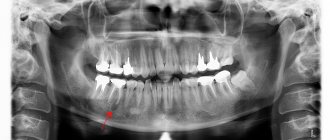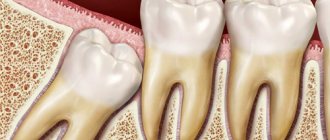From this article you will learn:
- the gums around the wisdom tooth are inflamed: what to do,
- wisdom tooth: hood and its removal (price for 2021),
- how to relieve inflammation.
The article was written by a dental surgeon with more than 19 years of experience.
Difficulty in the eruption of wisdom teeth is often accompanied by the development of inflammation of the gums around them. The mucous membrane of the gums, which partially covers the crown of the erupting wisdom tooth, is called the wisdom tooth hood (Fig. 1-3).
Because The hood over the wisdom tooth is not tightly adjacent to the crown of the tooth - a semi-closed space is formed between them, in which favorable conditions are created for the proliferation of pathogenic bacteria and the development of inflammation. In dentistry, an inflamed hood on a wisdom tooth is usually called “pericoronitis.”
Content:
- Symptoms of the disease
- How to understand that you need to remove the figure eight hood
- Preparing for surgery
- Progress of the operation to remove the tooth hood
- Rehabilitation period
Wisdom teeth often cause problems during eruption.
As it grows, the shell of gum tissue covering it begins to rise and loses its tightness. As a result, a gap is formed between the gum and the unit. Dentists call it the “hood.” Residues of food accumulate in it. It is not possible to remove them using normal hygiene procedures. Hence - an inflammatory process that is difficult to treat, a rapid spread of painful microflora in the mouth . The gum covering the “eight” swells, increases in size, and becomes painful to the touch.
This inflammation in dentistry is called pericoronitis. It requires urgent dental care as it can lead to dangerous complications. In most cases, the patient is recommended to undergo a tooth hood removal procedure.
Diagnostics
Any dentist can perform the diagnosis. To do this, you should study the symptoms and take an x-ray. Using the image, the doctor will see how the tooth is located, the condition of the bone tissue that surrounds it, as well as the condition of the periodontium. If the disease is chronic, then bone resorption is studied. Pericoronitis is treated by dentists in our dental center.
Symptoms of the disease
The problem does not manifest itself immediately. At first, when food debris has not yet accumulated under the soft tissues, there are no inflammatory symptoms. But later the disease manifests itself with the following symptoms:
- there is an unpleasant odor from the mouth;
- pain occurs in the area of inflammation;
- gums swell and often bleed.
If the wisdom tooth hood is not removed at this stage, the inflammatory reaction will begin to occur very quickly. Then the soft tissues surrounding the “eight” will become bright red, and pus will begin to ooze from the hood. While chewing food, the patient will experience unbearable pain. Due to severe discomfort, he will be forced to limit the mobility of the diseased jaw to the maximum.
The lymph nodes may also become involved in the inflammatory reaction. An increase in body temperature and the appearance of headaches are possible.
Why is excision done?
Pericoronitis is always associated with the formation of a gum hood. The tooth is cutting, but it is hampered by the gum tissue that is located on top. With this pathology, you can notice how the gum is swollen and hangs over the tooth, preventing the teeth from closing normally. To avoid complications, you should visit a doctor at the first signs of illness. The symptoms of the pathology are characterized by a gradual increase:
- sharp pain that radiates to the ear;
- difficulty chewing food due to loose rows of teeth;
- swelling of the gum tissues, changing their color to a darker one;
- inflammation of the lymph nodes located near the tooth;
- pus between the gum tissue and the tooth.
How to understand that you need to remove the figure eight hood
- Doctors insist on surgical treatment if:
- pus accumulates between the molar and gum;
- the pain is so severe that it is even difficult for a person to talk;
- signs of acute gingivitis appear, surrounding tissues are included in the pathological process;
- pain radiates to the temple, neck, lymph nodes;
- body temperature often rises.
All these symptoms indicate that the inflammation is very strong and measures need to be taken as soon as possible to eliminate it.
Stages of the procedure in Clarimed dentistry
Removal of the hood is carried out according to the following algorithm:
- Examination of the patient, determining the causes of the problem and the degree of development of the disease, collecting the necessary tests.
- Based on the collected medical history, an anesthetic is selected and anesthesia is administered. Clarimed dentistry uses only modern, certified and safe drugs that reliably protect the patient from pain and discomfort during the operation.
- The dentist uses a scalpel to cut through the mucous membrane and free the molar crown. Excess tissue is removed and the area is treated with an antiseptic.
- In case of critical damage to the wisdom tooth or its abnormal growth, the molar is removed by extraction in whole or in parts. The resulting hole is disinfected, bone shavings are placed in it, and the mucous membrane is sutured.
- A drug is applied to the wound to speed up healing. In case of serious intervention, a drainage is installed to remove the ichor. The patient is given the necessary consultations and is sent home.
After the intervention, it is recommended not to eat for 3 hours, not to smoke or drink alcohol. It is not recommended to visit the sauna, take a hot bath or go to the gym on this day (strong physical activity can lead to renewed bleeding).
Preparing for surgery
You should not be afraid of dental hood removal surgery. It is performed under local anesthesia and does not cause serious discomfort to the patient. But for therapy to be successful, it is important to carefully prepare for it.
First, the doctor talks with the patient and listens to his complaints, finds out how long ago the inflammation occurred and how much it bothers him. Then he examines the oral cavity and palpates the inflamed area. Writes out a referral for radiography. Based on the diagnostic results, he decides whether the wisdom tooth can be saved.
A mandatory stage of preparation for surgery is taking blood tests for coagulation and some other indicators. If the inflammation is severe, the client may be prescribed antibiotics before surgery to stabilize the situation and create optimal conditions for excision of the overhanging hood.
If the doctor deems it necessary, he will first perform professional oral hygiene. During this procedure, he will remove accumulations of hard and soft dental plaque. This is necessary in order to reduce the likelihood of postoperative inflammation.
Complications and care after surgery
Care
After the procedure, patients are advised to avoid cold and hot foods or drinks for several hours. For quick and painless healing it is recommended:
- rinse your mouth with cool antiseptics: potassium permanganate solution, Chlorhexidine, Miramistin, Stomatidine or Rivanol;
- apply cold to the operated area;
- take painkillers and anti-inflammatory drugs: Nimesil, Nurofen, Sedalgin, Solpadein, Tempalgin, Ketanov, Baralgin.
In case of purulent processes, antimicrobial therapy is additionally prescribed and antibiotics are prescribed - Metronidazole in combination with Clindomycin, Lincomycin, or medications based on Norfloxacin, Ciprofloxain or Ofloxacin.
Warm compresses and rinses are categorically unacceptable, because in warmth bacteria multiply and inflammation worsens!
It is important to maintain oral hygiene and use a brush with toothpaste every time after eating. The operation area must be carefully avoided. If the pain is too severe, it is recommended to rinse your mouth with toothpaste diluted in water.
Possible complications
With correctly performed excision and high-quality postoperative care, there are no complications. However, if bacteria enter the wound, the inflammation continues to progress. A hood again forms over the erupting crown, and it is recommended to remove the “eight”.
Progress of the operation to remove the tooth hood
When the treatment plan is drawn up, the patient has undergone the necessary preparation, and the operation is performed. It includes the following steps:
Introduction of anesthetic. The painkiller is selected on an individual basis. It is important that the patient is not allergic to it.- Excision of inflamed tissues hanging over the wisdom tooth. To do this, use a scalpel or special surgical scissors. The doctor carefully exposes the entire dental crown so that it can freely erupt to the end.
- Treatment of the resulting wound surface with an antiseptic. Removal of food debris and pus. After this, apply a turunda or compress with a wound-healing solution. It is needed to reduce the likelihood of pathogens entering the wound.
After the operation, the person can go home immediately. But on the appointed day he needs to appear for a second examination. Scheduled visits to a dental surgeon are required until the wound has completely healed.
Pericoronitis: treatment
If you have inflammation of the gums near the wisdom tooth, the treatment most often consists of a dental surgeon removing the hood over the wisdom tooth. However, if severe purulent inflammation is observed, then complete excision of the hood is undesirable immediately, because this can lead to various inflammatory complications.
In case of severe purulent inflammation, the hood is first only dissected to facilitate the outflow of purulent discharge, and anti-inflammatory therapy is prescribed. And the doctor will prescribe you for its complete removal after the active inflammation has subsided. Also, in some cases, the doctor may recommend immediately removing the wisdom tooth (24stoma.ru).
Excision of the hood over the wisdom tooth –
Removing the hood of a wisdom tooth involves excision of the overhanging mucous membrane over the erupting eighth tooth. Excision of the hood over the wisdom tooth leads to the elimination of conditions for the proliferation of pathogenic bacteria. This minor surgical procedure is usually less traumatic, but in some cases a large amount of gum tissue must be excised.
Excision of the hood over the wisdom tooth is performed by a dental surgeon under local anesthesia. The procedure is completely painless if you see a good specialist, if the anesthesia is administered correctly and a good anesthetic is used, and not something like novocaine. Pain will appear only after anesthesia has passed (after 30 minutes), so it is worth taking an analgesic even before the pain appears.
- Hood removal: price for 2021 in an economy class clinic in Moscow, a similar service costs about 2,500 rubles. In the regions, the cost of the procedure may be 2 times lower. By the way, in the clinic at your place of residence (if you have an insurance policy and a passport), you should undergo this intervention completely free of charge.
Stages of excision of the hood –
- Conducting local anesthesia,
- Using a scalpel and surgical scissors (less commonly, a surgical laser), the dental surgeon excises the gum overhanging the tooth.
- Treating the wound with antiseptics.
- An iodoform turunda is usually placed in place of the excised hood.
- The doctor gives recommendations and schedules a re-examination.
Removing a wisdom tooth hood: video
Please note that both hood excision operations are performed with a surgical laser and not with a scalpel. Using a laser avoids bleeding, swelling and severe pain. In Russian dental clinics, lasers are practically not used (due to their absence), and only a few clinics can boast of their presence.
After the intervention, the following are prescribed:
- Antiseptic baths with chlorhexidine solution 0.05% (3-4 times a day);
- Antibiotics are not prescribed in every case;
- for pain - good tablet analgesics.
Usually this is enough for you to completely forget what wisdom tooth pericoronitis is after 4-5 days.
However, if the doctor performed the operation traumatically, the pain may last for 7-10 days. If you want to remove inflammation as quickly as possible, then after antiseptic rinses, you can additionally apply CholisalGel to the hood 2 times a day in the morning and evening (it has a pronounced analgesic and anti-inflammatory effect). Remember that if you put gauze soaked in iodoform on the wound surface, you need to remove it yourself no later than the next day. Then it itself will become a breeding ground for infection. After you take out this turunda, it may cover a little. Then it is advisable to treat the wound with a gauze swab soaked in 3% hydrogen peroxide.
Important: in some cases, the hood may form again, in which case either a repeat operation may be required, or the issue of tooth extraction will be decided. Often these teeth are in an incorrect position. An experienced doctor can quickly determine the chances of the eighth tooth taking the correct position using an x-ray and external examination of the tooth.
In what cases is it better to immediately remove a tooth with a hood -
If your gums near your wisdom tooth are inflamed, the most radical treatment method will be the removal of the 8th tooth, above which the ill-fated hood appears.
This will solve the problem permanently, but you must be prepared for the fact that the eighth teeth may have curved roots (this can be checked by taking a photo) and then removal may be difficult. Situations where deletion is the best solution to the problem -
- Firstly , when the lower jaw is insufficiently long, which means there is not enough space for the eruption of a wisdom tooth. Removal in this case will prevent the remaining teeth from being displaced by the erupting tooth, and will prevent the development of crowding of teeth in the anterior part of the lower jaw.
- Secondly , if the 8th tooth has a strong inclination towards the cheek or the seventh tooth, then it will still have to be removed sooner or later, because it will injure either the buccal mucosa or the root of the 7th tooth, respectively.
For more information about the difficult eruption of wisdom teeth, read the article: → “Features of the growth and eruption of eighth teeth”
Rehabilitation period
How long it will take for your gums to recover depends on many factors:
- volume of tissue removed;
- client age;
- individual characteristics of the patient’s body;
- correctness of the operation;
- accuracy of patient compliance with medical prescriptions.
To make rehabilitation as simple and fast as possible, you need to remember the rules:
- Do not eat for three hours after completion of surgical treatment.
- Remove the turunda (compress) only when the doctor tells you to. However, it should not be in the mouth for more than a day.
- Do not chew food on the same side of the jaw on which surgery was performed.
- Do not eat hot or very cold foods. The same goes for drinks.
- During hygiene procedures, do not touch the wound with a brush.
- Strictly take all medications prescribed by the dental surgeon.
- Do not self-medicate (it is unacceptable to try to speed up recovery using dubious folk methods).
If the patient listens to the advice of his doctor, the wound will heal quite quickly.
Treatment of inflammation of the hood over a wisdom tooth at home
Treatment at home can be effective only at the initial stage of the disease, before symptoms such as swelling, pus discharge, pain when swallowing and opening the mouth occur. The progression of the inflammatory process can be stopped using antibiotics in combination with treating the hood with chlorhexidine 0.05% and applying Cholisal gel. To do this, you need to: rinse your mouth with a solution of chlorhexidine 0.05 for 1 minute, then dry the gums with a sterile cloth or bandage. Apply a little gel to your finger and rub into the gums in a circular motion. After that, take a little more gel and apply it to the hood. At the end of the procedure, close your mouth, do not eat food for 3 hours, and swallow saliva. During the disease with pericoronitis, under no circumstances should you use warm compresses and warm rinses. This will lead to the rapid proliferation of pathogenic bacteria. You should not apply painkillers to a sore tooth, as they will not relieve the pain and can severely damage the mucous membrane. Such measures will only bring temporary relief and prolong the inflammatory process. It is better not to postpone a visit to the doctor in order to prevent serious complications. Particular attention should be paid to oral hygiene during tooth growth. If any inflammation occurs, contact your dentist immediately.
We cannot diagnose ourselves on our own, much less prescribe the necessary course of treatment. The sooner a qualified specialist determines the cause of inflammation, the less likely you will encounter complications!
How is the procedure performed?
Before starting the procedure, the dental surgeon takes into account all the individual characteristics of the patient: age, allergic reactions, chronic diseases, etc. After making sure that the procedure can be carried out, the doctor begins excision.
Stages of excision of the hood:
- X-ray diagnostics.
- Local anesthesia.
- Gum incision.
- Washing the wound.
- Applying a therapeutic bandage.
After surgery, the doctor schedules a follow-up appointment to examine the wound. As a rule, the gums heal in about ten days. If the process is delayed, this may be a symptom of complications.
